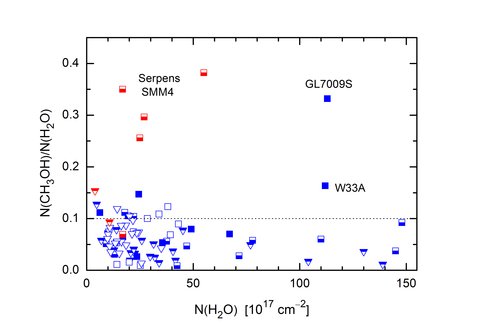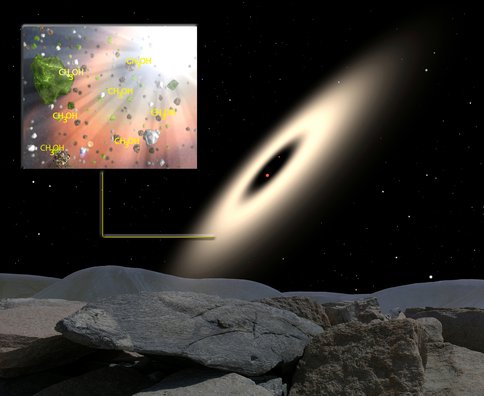2011 Annual Science Report
 Rensselaer Polytechnic Institute
Reporting | SEP 2010 – AUG 2011
Rensselaer Polytechnic Institute
Reporting | SEP 2010 – AUG 2011
Project 1: Interstellar Origins of Preplanetary Matter
Project Summary
Interstellar space is rich in the raw materials required to build planets and life, including essential chemical elements (H, C, N, O, Mg, Si, Fe, etc.) and compounds (water, organic molecules, planet-building minerals). This research project aims to characterize the composition and structure of these materials and the chemical pathways by which they form and evolve. The long-term goal is to determine the inventories of proto-planetary disks around young sun-like stars, leading to a clear understanding of the processes that led to our own origins and insight into the probability of life-supporting environments emerging around other stars.
Project Progress
(a) Observations
The primary accomplishment during the reporting period was the completion of a major study of the abundance and distribution of methanol (CH3OH) in interstellar and preplanetary ices. Methanol is a vital molecule in the chemical evolution of preplanetary matter for two reasons: (1) it can be synthesized at very low temperature by surface hydrogenation reactions on dust grains in the cold molecular clouds that give birth to new stars, and (2) it readily participates in reactions that synthesize far more complex organic molecules by photochemical reactions and other energetic processes that become activated when stars form within the clouds. Methanol is thus thought to be a key link in the chain of astrochemical evolution from atoms and very simple interstellar molecules (H, O, OH, CO) to complex prebiotic molecules observed in hot cores and in primitive solar system bodies.
A detailed survey of new and previously published data from the literature on methanol in astrophysical ices has been completed and accepted for publication (Whittet et al. 2011). Methanol concentrations vary from trace amounts in many regions to approximately 30 percent of the ices around a select group of newly formed stars; concentrations in the quiescent clouds that will eventually give birth to new stars lie toward the lower end of this range. On the basis of comparisons between the data and models, we conclude that methanol production is highly sensitive to local conditions. The rate of mantle growth and the degree of previous CO freeze-out appear to be critical parameters: a “sweet spot” is reached when CO and atomic H accumulate onto grain surfaces at approximately equal rates. If CO accumulates too rapidly, it becomes buried in the ice mantle (and rendered chemically inactive) before significant hydrogenation can occur. Favorable conditions are found in the outer regions of circumstellar envelopes around certain young stars (see schematic and plot below). Notable examples include the high-mass protostars W33A and GL7009S, and the solar-mass protostar Serpens SMM4. The plot compares abundances for our entire sample (points) with the range of methanol abundances observed in comets (the dotted line representing the upper bound). Stars with the greatest methanol concentrations have the greatest potential for further chemical evolution, and it is not obvious that our solar system was particularly “lucky” in this regard.
A plot of methanol abundance relative to water in cosmic ices as a function of water-ice column density (equivalent to the total mass of ice in the line of sight). Filled and half filled symbols represent high-mass and solar-mass young stellar objects, respectively, and open symbols represent field stars that sample quiescent molecular clouds prior to the onset of star formation. Inverted triangles denote upper limits. Stars in the Serpens star-formation region are plotted in red. The horizontal dotted line represents the abundance of methanol in cometary ices from Mumma & Charnley (2011).
Schematic illustration of methanol chemistry in a protoplanetary disk, used to illustrate a Rensselaer Polytechnic Institute press release “Astrobiologists Discover Sweet Spots for the Formation of Complex Organic Molecules in the Galaxy” (November 2, 2011), subsequently picked up by numerous science news feeds nationally.
Work on several other observational projects has continued during the year, including studies of gas-phase C18O and N2H+ molecules in the Rossano Cloud B in the Corona Australis molecular cloud (reported in a poster at the Spring 2011 meeting of the American Astronomical Society; Hardegree-Ullman et al. 2011), and polycyclic aromatic hydrocarbons in the isolated globule DC314.8-5.1 (reported in posters at both the AAS and the IAU Symposium on the Molecular Universe; Shenoy et al. 2011). We expect to discuss results for these projects in detail in next year’s report.
(b) Astrochemical Modeling
Significant progress has been made in our quest to develop astrochemical models to simulate the chemistry of regions of the interstellar medium along the evolutionary trail from prestellar clouds to the formation of stars and planets. In order to simulate regions, such as the inner portions of protoplanetary disks, that are heated by a newly-born star, we have extended the upper limit of temperature of our gas-phase chemical network to 800 K by adding a significant number of reactions that occur at high temperature. The new network has been placed on our web site for general usage:
http://www.physics.ohio-state.edu/~eric/
As a result, we are now able to study portions of protoplanetary disks near their young central star, and so simulate the chemistry in the interesting region 1–10 AU from the star. We have also further developed a sensitivity analysis for determining to which parameters the results of simulations are most sensitive. Among the most important parameters are the rates of specific chemical reactions, and so the sensitivity analysis can be utilized to determine which reactions should be studied in the laboratory, either for the first time, or to determine more accurate results than with previous studies.
In a simulation that contains surface chemistry as well as gas-phase chemistry, we have shown that in hot cores such as Sgr B2(N), gas-phase processes can alter the predictions of complex molecule abundances obtained via surface reactions followed by thermal desorption into the gas (Laas et al. 2011). For example, the lowest energy isomer of methyl formate, the so-called cis form, is produced primarily on grain surfaces, while the higher energy trans isomer is formed in the gas at higher temperatures. We therefore predict a spatial variation between the two isomers.
In our gas-grain simulations, we have in the past used only dust grains of a single size (0.1 mm). In our most recent publication, we have shown how the calculated chemical abundances are affected by the use of time-dependent grain-size distributions (Acharyya et al. 2011).
Publications
-
Acharyya, K., Hassel, G. E., & Herbst, E. (2011). THE EFFECTS OF GRAIN SIZE AND GRAIN GROWTH ON THE CHEMICAL EVOLUTION OF COLD DENSE CLOUDS. The Astrophysical Journal, 732(2), 73. doi:10.1088/0004-637x/732/2/73
-
Chiar, J. E., Pendleton, Y. J., Allamandola, L. J., Boogert, A. C. A., Ennico, K., Greene, T. P., … Eriksson, K. (2011). ICES IN THE QUIESCENT IC 5146 DENSE CLOUD. The Astrophysical Journal, 731(1), 9. doi:10.1088/0004-637x/731/1/9
-
Cook, A. M., Whittet, D. C. B., Shenoy, S. S., Gerakines, P. A., White, D. W., & Chiar, J. E. (2011). THE THERMAL EVOLUTION OF ICES IN THE ENVIRONMENTS OF NEWLY FORMED STARS: THE CO 2 DIAGNOSTIC. The Astrophysical Journal, 730(2), 124. doi:10.1088/0004-637x/730/2/124
-
Laas, J. C., Garrod, R. T., Herbst, E., & Widicus Weaver, S. L. (2011). CONTRIBUTIONS FROM GRAIN SURFACE AND GAS PHASE CHEMISTRY TO THE FORMATION OF METHYL FORMATE AND ITS STRUCTURAL ISOMERS. The Astrophysical Journal, 728(1), 71. doi:10.1088/0004-637x/728/1/71
-
Quan, D., Herbst, E., Osamura, Y., & Roueff, E. (2010). GAS-GRAIN MODELING OF ISOCYANIC ACID (HNCO), CYANIC ACID (HOCN), FULMINIC ACID (HCNO), AND ISOFULMINIC ACID (HONC) IN ASSORTED INTERSTELLAR ENVIRONMENTS. The Astrophysical Journal, 725(2), 2101–2109. doi:10.1088/0004-637x/725/2/2101
-
Whittet, D. C. B., Cook, A. M., Herbst, E., Chiar, J. E., & Shenoy, S. S. (2011). OBSERVATIONAL CONSTRAINTS ON METHANOL PRODUCTION IN INTERSTELLAR AND PREPLANETARY ICES. The Astrophysical Journal, 742(1), 28. doi:10.1088/0004-637x/742/1/28
- Gibb, E.L. (2011). Searching for prebiotically important molecules in protoplanetary disks. Origins 2011 conference. Montpellier, France.
- Hardegree-Ullman, Emily, E., Horne, D., Whittet, D., Harju, J., Spizuco, J. & Mayeur, P. (2011). C18O and N2H+ Gas Phase Observations Toward Rossano Cloud B in the Corona Australis Molecular Cloud Complex. Bulletin of the American Astronomical Society, 43(129.11).
- Shenoy, S.S., Whittet, D.C.B., Pendleton, Y.J., Boersma, C., Allamandola, L.J., Horne, D. & Mayeur, P.A. (2011). A Spitzer Survey of an Isolated Globule: DC314.8-5.1. Bulletin of the American Astronomical Society, 43(321.06).
- Shenoy, S.S., Whittet, D.C.B., Pendleton, Y.J., Boersma, C., Allamandola, L.J., Horne, D. & Mayeur, P.A. (2011). A Spitzer Survey of an Isolated Globule: DC314.8-5.1. The Molecular Universe, Proceedings of the 280th Symposium of the International Astronomical Union. Toledo, Spain.
- Whittet, D.C.B. (2011). Interstellar Dust. In: Springer-Verlag (Eds.). Encyclopedia of Astrobiology.
- Whittet, D.C.B. (2011). Interstellar Ices. In: Springer-Verlag (Eds.). Encyclopedia of Astrobiology.
- Whittet, D.C.B. (2011). The origin and distribution of interstellar methanol ice: The route to complex organic molecules in preplanetary matter. Origins 2011 conference. Montpellier, France.
-
PROJECT INVESTIGATORS:
-
PROJECT MEMBERS:
Jean Chiar
Collaborator
Amanda Cook
Collaborator
Perry Gerakines
Collaborator
Erika Gibb
Collaborator
Jorma Harju
Collaborator
Eric Herbst
Collaborator
Yvonne Pendleton
Collaborator
Sachindev Shenoy
Collaborator
David Horne
Postdoc
Emily Hardegree-Ullman
Graduate Student
Paul Mayeur
Graduate Student
Steven Lentine
Undergraduate Student
Joseph Spizuco
Undergraduate Student
-
RELATED OBJECTIVES:
Objective 1.1
Formation and evolution of habitable planets.
Objective 3.1
Sources of prebiotic materials and catalysts


